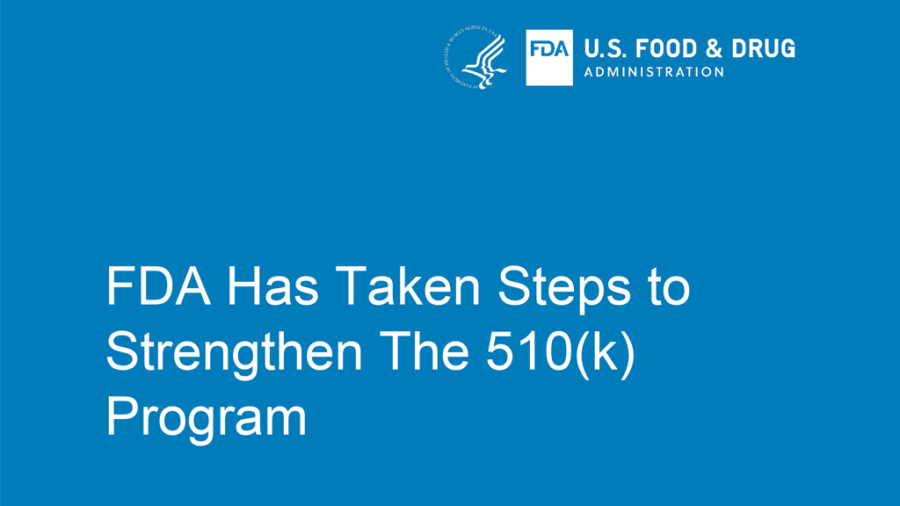Written by Emre Ertugrul
The Food and Drug Administration has announced on Nov. 26 its plans on modernizing the 510(k) process – a regulation that allows new medical devices to get fast approval based on similar devices that are already on the US market.
The agency is seeking improved quality and safety for patients through new plans including increasing the premarket expectations, maintaining the 510(k)-refusal checklist and increasing the time spent in the reviews.
With fast-paced technological advancements and research, the medical device industry has gained itself a big place on the market, while the 510(k) process has even helped with the fast-track approvals based on predicate devices that are already on the market – with some of which being more than 10 years old.
The agency hopes to “keep pace with the increasing complexity of rapidly evolving technology,” while ensuring that new devices meet more detailed and modern safety criteria, the statement read. The Refuse-to-Accept policy will reject 510(k) applications that do not meet the 52-item criteria of the FDA.
Earlier in April, the FDA had announced its new “Medical Device Safety Action Plan” in order to promote public health with more regulatory options to “streamline and modernize timely implementation of post-market mitigations.”
In the most recent statement, the FDA has announced that new feedbacks regarding the April Safety Action Plan have urged the agency to take steps for actions to modernize the predicate device criteria in an effort to improve safety and innovation.
“We believe that newer devices should be compared to the benefits and risks of more modern technology; that is why we’re looking at ways to promote the use of more recent predicates,” the agency announced in the statement.
Under the current 510(k) process, a medical device can receive approval for the market if it is “substantially equivalent” to another device that is already on the market. However, predicates being too old and FDA’s limited responsibility during the post-market periods were at the center of the debate when injured patients and their families have filed thousands of lawsuits against drug makers and medical device manufacturers nationwide.
In an earlier story on SafetyWatch, Madris Tomes, founder and CEO of Device Events, has told that there can be recalled devices, but this would not mean that it will not be considered as a predicate device in the future.
In addition to that, the only regulation that the FDA follows is to see if the device is being requested for clearance.
The agency has stated that in the next few months, the Center for Devices and Radiological Health (CDRH) is considering listing on its website the cleared devices that demonstrated substantial equivalence to older predicate devices.
Another notable step taken in the process is the “Safety and Performance Based Pathway,” a new approach that will focus on “advancing improved safety and performance of new products” through a transparent stage in which a company would show the agency that a new device meets the performance-based criteria that have been recognized by the FDA.
As well as modernizing the process, the FDA also has stated that the CDRH has worked on eliminating the use of the cleared predicate devices that have raised safety concerns. Since Congress enacted the Medical Device Amendments in 1976, the FDA has eliminated the use of 1,758 devices as predicates during the 510(k) process. The statement added that 1,477 of these have been eliminated since 2012. The FDA is expecting a 30-fold increase in the annual rate of elimination.
As well as the elimination process, a new update on high-risk devices will be implemented. The FDA is intending to close paths to 510(k) applications for Class III devices with predicates. Class III devices, including those with the greatest risk to patients, have to obtain an approved Pre-market Approval (PMA); however, some devices on the market before the 1976 Amendment were classified as Class III and can be cleared through the 510(k) process. The FDA has published new rules for re-classifying devices and premarket submissions between 2011 and 2016. The statement read that “as a result of these actions, not a single Class III device was cleared via the 510(k) process in FY 2018.”
The FDA’s “modernizing” program and proposals will be shaped in the following months after feedbacks from the public and the new Congress.

Emre Ertugrul
Emre Ertugrul is a reporter for Safetywatch.org, covering controversial drugs and medical devices, reporting on health policy and the FDA. He studied journalism with concentration in investigative reporting at Boston University. Previous experience with the New England Center for Investigative Reporting include tax issues, racial profiling and criminal justice. He also worked as an international news intern at Milliyet Newspaper and is currently one of the editors for Gazet.com.


